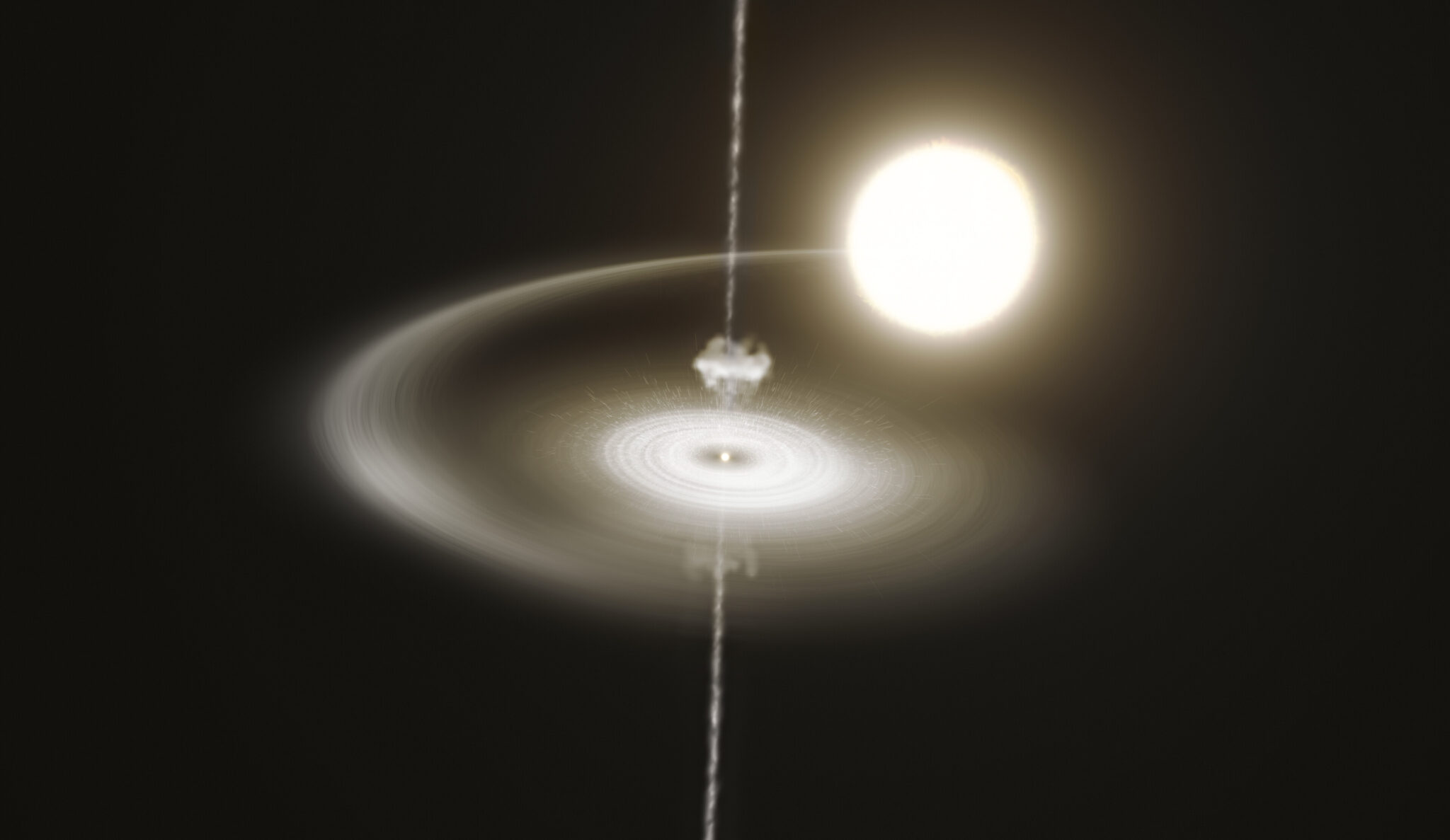Astronomers unravel a pulsar’s bizarre behaviour
- PSR J1023+0038 is a special type of pulsar located about 4500 light-years away in the Sextans constellation, which closely orbits another star
- The pulsar switches between two modes, from giving off bright X-rays, ultraviolet and visible light to emitting dimmer light and more radio waves
- This switching has thus far puzzled astronomers

Legend: Artist’s impression of the pulsar PSR J1023+0038.
Credits: ESO/M. Kornmesser.
An international team of astronomers has uncovered the strange behaviour of a pulsar—a super-fast-spinning dead star—that switches between two brightness modes almost constantly. Thanks to an observational campaign that involved 12 telescopes both on the ground and in space, including three European Southern Observatory (ESO) facilities, the team found that sudden ejections of matter from the pulsar over very short periods are responsible for the peculiar switches.
The research, published today in Astronomy & Astrophysics, has the highlighted contribution of the members of the Institute of Space Studies of Catalonia (IEEC) Francesco Coti Zelati and Diego F. Torres, researchers at the Institute of Space Sciences (ICE-CSIC).
“We have witnessed extraordinary cosmic events where enormous amounts of matter, similar to cosmic cannonballs, are launched into space within a very brief time span of tens of seconds from a small, dense celestial object rotating at incredibly high speeds,” says Maria Cristina Baglio, researcher at New York University Abu Dhabi, affiliated with the Italian National Institute for Astrophysics (INAF), and the lead author of the article.
A pulsar is a fast-rotating, magnetic, dead star that emits a beam of electromagnetic radiation into space. As it rotates, this beam sweeps across the cosmos — much like a lighthouse beam scanning its surroundings — and is detected by astronomers as it intersects the line of sight to Earth. This makes the star appear to pulse in brightness as seen from our planet.
PSR J1023+0038, or J1023 for short, is a special type of pulsar with a bizarre behaviour. Located about 4,500 light-years away in the Sextans constellation, it closely orbits another star. Over the past decade, the pulsar has been actively pulling matter off this companion, which accumulates in a disc around the pulsar and slowly falls towards it.
Video
Since this process of accumulating matter began, the sweeping beam virtually vanished and the pulsar started incessantly switching between two modes. In the ‘high’ mode, the pulsar gives off bright X-rays, ultraviolet and visible light, while in the ‘low’ mode it’s dimmer at these frequencies and emits more radio waves. The pulsar can stay in each mode for several seconds or minutes, and then switch to the other mode in just a few seconds. This switching has thus far puzzled astronomers.
“Our unprecedented observing campaign to understand this pulsar’s behaviour involved a dozen cutting-edge ground-based and space-borne telescopes,” says ICE-CSIC and IEEC researcher Coti Zelati, co-lead author of the paper. “We have discovered that the mode switching stems from an intricate interplay between the pulsar wind, a flow of high-energy particles blowing away from the pulsar, and matter flowing towards the pulsar,” he adds.
The campaign included ESO’s Very Large Telescope (VLT) and New Technology Telescope (NTT), which detected visible and near-infrared light, as well as the Atacama Large Millimeter/submillimeter Array (ALMA), in which ESO is a partner. Over two nights in June 2021, the telescopes observed the system make over 280 switches between its ‘high’ and ‘low’ modes.
“Our unprecedented observing campaign to understand this pulsar’s behaviour involved a dozen cutting-edge ground-based and space-borne telescopes,” says ICE-CSIC and IEEC researcher Coti Zelati, co-lead author of the paper.
In the low mode, matter flowing towards the pulsar is expelled in a narrow jet perpendicular to the disc. Gradually, this matter accumulates closer and closer to the pulsar and, as this happens, it is hit by the wind blowing from the pulsating star, causing the matter to heat up. The system is now in a high mode, glowing brightly in the X-ray, ultraviolet and visible light. Eventually, blobs of this hot matter are removed by the pulsar via the jet. With less hot matter in the disc, the system glows less brightly, switching back into the low mode.
While this discovery has unlocked the mystery of J1023’s strange behaviour, astronomers still have much to learn from studying this unique system and ESO’s telescopes will continue to help astronomers observe this peculiar pulsar. In particular, the Extremely Large Telescope (ELT), currently under construction in Chile, will offer an unprecedented view of J1023’s switching mechanisms.
Press release prepared in collaboration with the Institute of Space Sciences (ICE-CSIC).
More information
This research is presented in a paper entitled “«Matter ejections behind the highs and lows of the transitional millisecond pulsar PSRJ1023+0038”, by M.C. Baglio, F. Coti Zelati, et al., to appear in the journal Astronomy & Astrophysics on 30 August 2023.
Contacts
IEEC Communication Office
Barcelona, Spain
E-mail: comunicacio@ieec.cat
Lead Researcher at the IEEC
Barcelona, Spain
Francesco Coti Zelati
Institute of Space Studies of Catalonia (IEEC)
Institute of Space Sciences (ICE-CSIC)
E-mail: cotizelati@ieec.cat; cotizelati@ice.csic.es
